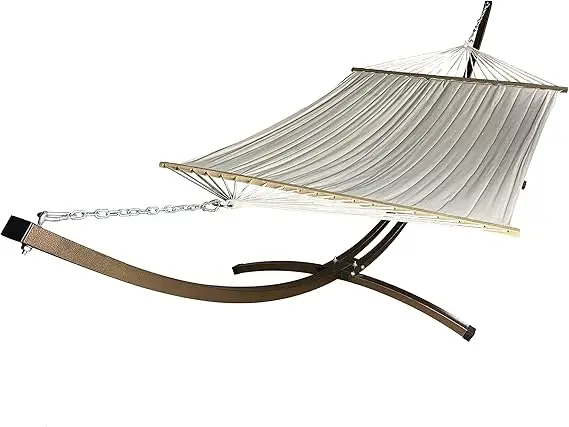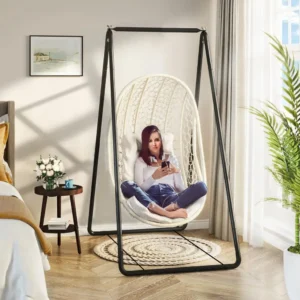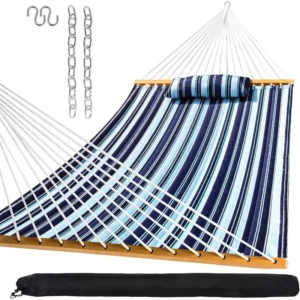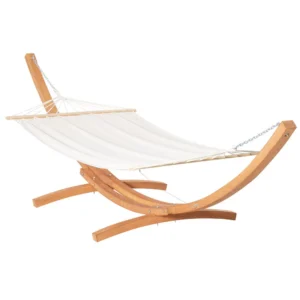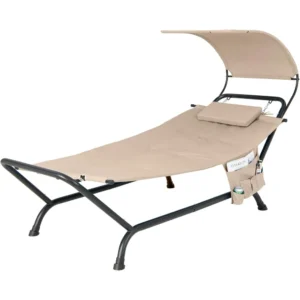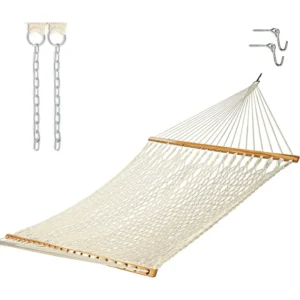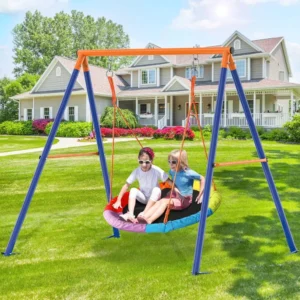Quick Comparison: Cotton vs. Polyester Rope Hammocks at a Glance
| Feature | Cotton Rope Hammocks | Polyester Rope Hammocks |
|---|---|---|
| Comfort | ★★★★★ | ★★★☆☆ |
| Durability | ★★☆☆☆ | ★★★★★ |
| Weather Resistance | ★☆☆☆☆ | ★★★★★ |
| Maintenance Required | ★★☆☆☆ (High) | ★★★★★ (Low) |
| Initial Softness | ★★★★★ | ★★★☆☆ |
| UV Resistance | ★☆☆☆☆ | ★★★★★ |
| Mold/Mildew Resistance | ★★☆☆☆ | ★★★★★ |
| Typical Lifespan | 3-5 years | 7-10+ years |
| Cost | ★★★☆☆ (Moderate) | ★★☆☆☆ (Higher) |
| Best For | Indoor use, covered porches, softness priority | Outdoor exposure, durability priority, low maintenance |
Choosing between cotton and polyester rope hammocks comes down to understanding what matters most for your relaxation needs. While cotton offers unmatched natural comfort and a traditional feel, polyester provides outstanding durability and weather resistance. The right choice depends largely on where you’ll place your hammock and how you prioritize initial comfort versus long-term durability.
The placement of your hammock significantly impacts which material will serve you best. Before making your decision, consider exploring our collection of rope hammock sets to see the differences in construction and design.
Understanding Rope Hammock Materials: The Basics
Rope hammocks represent the classic hammock design most people envision when dreaming of backyard relaxation. Unlike fabric hammocks that use a solid piece of material, rope hammocks feature an open, breathable weave pattern created by interlacing ropes in a grid-like formation. This design allows for excellent airflow, making them particularly comfortable in warm weather.
The two primary materials used in today’s rope hammocks are cotton and polyester, each with distinct properties that affect everything from comfort to durability. Cotton is a natural fiber harvested from cotton plants, while polyester is a synthetic material made from petroleum-based chemicals.
Rope thickness typically ranges from 3/16 inch to 1/4 inch in diameter, with spacing between ropes affecting both comfort and support. Tighter weaves generally provide better support but reduce airflow, while more open weaves offer greater breathability but may leave imprint patterns on skin.
Your choice between these materials should reflect your priorities and usage environment. For deeper insights into how these materials compare across different criteria, our cotton vs polyester hammock comparison provides additional details. You might also want to examine different spreader bar hammock designs to see how construction affects comfort in both materials.
Cotton Rope Hammocks: Natural Comfort Explained
Cotton rope hammocks have earned their reputation as the gold standard for comfort in the hammock world. Made from natural plant fibers, cotton provides a soft, yielding texture that gently cradles the body. Premium cotton hammocks often use long-staple cotton varieties, which feature longer fibers that create stronger, smoother ropes with fewer loose ends.
The manufacturing process for cotton hammock rope typically involves twisting multiple strands together to create a soft yet sturdy cord. This process retains cotton’s natural properties while increasing its strength for hammock use. The end result is a rope that feels natural against the skin and has a pleasant, organic appearance.
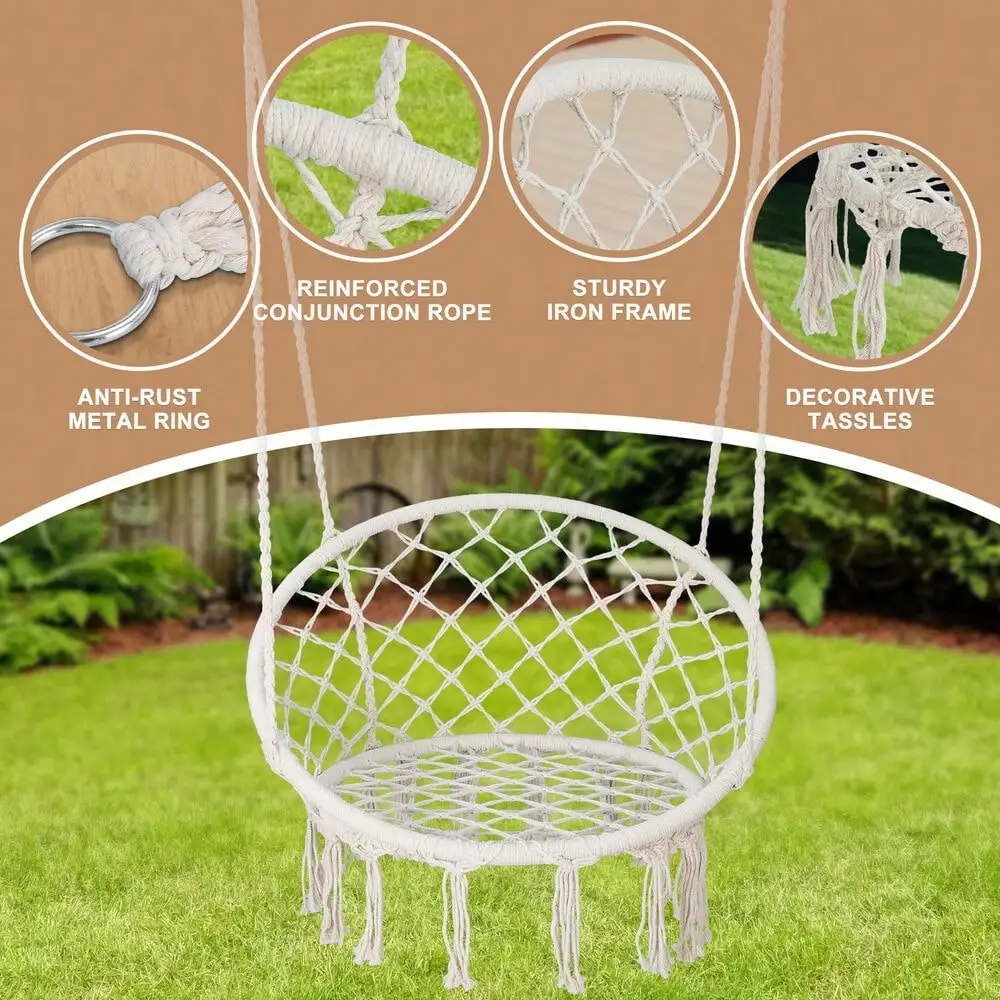
Advantages of Cotton Rope Hammocks:
* Exceptionally soft and comfortable against skin
* Naturally conforms to body contours
* Breathable material that prevents overheating
* Traditional, classic appearance
* No synthetic feel or sound
Disadvantages of Cotton Rope Hammocks:
* Vulnerable to weather damage
* Requires more maintenance
* Shorter lifespan, especially when left outdoors
* Prone to mildew and mold growth
* Slower drying time after exposure to moisture
For those planning to use their hammock primarily outdoors, understanding proper cotton rope hammocks outdoor use practices becomes essential for maximizing their lifespan.
The Comfort Factor: Why Many Choose Cotton
The distinctive comfort of cotton rope hammocks comes from a combination of natural properties that synthetic materials struggle to replicate. Cotton fibers have a natural give that allows the rope to stretch slightly and conform perfectly to your body shape. This creates that perfect “hammock hug” feeling that many relaxation enthusiasts crave.
The tactile experience of cotton is unmatched – similar to the comfort of your favorite well-worn cotton t-shirt. The soft, slightly textured surface feels gentle against bare skin, unlike some synthetic materials that can feel slick or plasticky.
Cotton’s natural breathability also contributes significantly to its comfort. The fibers wick moisture away from the body and allow air to circulate freely, preventing the sticky, sweaty feeling that can occur with some synthetic materials, especially during hot weather.
For couples or families looking to share relaxation time, double two-person hammock sets in cotton provide an exceptionally comfortable lounging experience, though with some considerations about weight capacity and durability.
Durability Concerns: Cotton’s Achilles Heel
While cotton excels in comfort, its durability presents significant challenges, especially for outdoor use. As a natural fiber, cotton is highly susceptible to environmental damage from various sources:
- UV Exposure: Sunlight gradually weakens cotton fibers, causing them to become brittle and prone to breaking.
- Moisture Absorption: Cotton absorbs water readily, leading to prolonged dampness that promotes rot and weakening of fibers.
- Mildew and Mold: The organic nature of cotton makes it an ideal breeding ground for fungi when damp.
- Freeze/Thaw Cycles: When wet cotton freezes and thaws repeatedly, the expanding water damages fiber integrity.
A cotton hammock left outdoors year-round may show significant deterioration within a single season, while the same hammock stored properly when not in use might last 3-5 years. Signs of wear include visible fraying, rope thinning, discoloration, and loss of tension.
Understanding whether it’s okay to leave your hammock outside is critical for making informed decisions about which material best suits your lifestyle and maintenance preferences.
Polyester Rope Hammocks: Built to Last
Polyester rope hammocks represent the evolution of hammock technology, addressing many of the durability concerns that plague traditional cotton versions. Made from synthetic polymer fibers, polyester offers remarkable resilience in outdoor settings while manufacturers have worked to improve its comfort characteristics.
Modern polyester hammock ropes have come a long way from the stiff, uncomfortable synthetic cords of the past. Today’s high-quality polyester ropes, including specialized varieties like DuraCord, feature soft-spun technology that creates a more pleasant feel while maintaining exceptional strength. These ropes typically have a tensile strength several times greater than cotton, allowing them to support heavier weights without stretching or breaking.
Advantages of Polyester Rope Hammocks:
* Outstanding weather resistance and durability
* Minimal maintenance requirements
* Resistance to mold, mildew, and rot
* Faster drying time when wet
* Consistent tension and support over time
* Color-fast properties that resist fading
Disadvantages of Polyester Rope Hammocks:
* Initially less soft than cotton
* Can feel slightly synthetic against bare skin
* May be noisier than cotton (slight squeaking)
* Typically higher initial cost
* Less traditional aesthetic appeal
For those prioritizing strength and longevity, our heavy duty hammock sets feature premium polyester construction designed to withstand years of regular use.
Weather Warriors: Polyester’s Outdoor Advantage
Polyester’s exceptional weather resistance makes it the undisputed champion for permanent outdoor hammock installations. This synthetic material shrugs off environmental challenges that would quickly degrade cotton:

Unlike cotton, which acts like a sponge, polyester repels water rather than absorbing it. After a rainstorm, a polyester hammock typically dries within 1-2 hours, compared to cotton’s 8+ hours. This quick-drying property significantly reduces the risk of mold and mildew development.
Polyester’s UV resistance is particularly impressive, with minimal degradation even after years of sun exposure. While cotton fibers break down and weaken in sunlight, quality polyester maintains its strength and color. This makes it especially valuable in sunny locations like poolsides, beaches, or unshaded backyards.
In coastal environments with high humidity and salt exposure, polyester’s resistance to environmental damage becomes even more pronounced. While cotton quickly deteriorates in these conditions, polyester remains structurally sound and attractive.
For comprehensive protection of your outdoor relaxation space, exploring weather protection for patio hammock chairs provides additional strategies beyond material selection.
The Comfort Evolution: Modern Polyester Feel
Modern manufacturing techniques have revolutionized the comfort level of polyester rope hammocks. Today’s premium polyester hammocks feature soft-spun technology that creates a significantly more pleasant tactile experience than earlier generations of synthetic hammocks.
While traditional polyester rope could feel stiff and plastic-like, soft-spun polyester has a more cotton-like hand feel with reduced roughness. The fibers are processed to create a softer, more pliable rope that reduces the “synthetic” sensation against skin. Some premium versions even incorporate texturing techniques that mimic cotton’s natural feel.
Rope thickness and tension significantly affect the comfort of polyester hammocks. Thicker ropes (around 1/4 inch) with proper spacing create a more comfortable support surface than thinner varieties. Similarly, proper installation with the right amount of hammock installation requirements and safety guidelines ensures optimal comfort regardless of material.
While polyester still doesn’t quite match the natural softness of cotton, the comfort gap has narrowed dramatically. For many users, the slight difference in initial comfort is a worthwhile tradeoff for polyester’s substantial advantages in durability and weather resistance.
Head-to-Head: Direct Comparison in Key Areas
When deciding between cotton and polyester rope hammocks, understanding how they perform in specific areas helps clarify which material best meets your needs:
Support and Body Contouring:
Cotton provides immediate comfort with a gentle, natural stretch that cradles the body. It molds to your shape from the first use but continues stretching over time, potentially requiring adjustment. Polyester offers more consistent support with minimal stretching even after years of use. While initially firmer, polyester maintains its intended shape and tension much longer.
Weight Capacity:
Quality polyester hammocks typically support 450-650 pounds, significantly outlasting cotton hammocks with similar weight ratings. Cotton’s weight capacity often diminishes over time as fibers stretch and weaken, while polyester maintains consistent strength throughout its lifespan.
Break-in Period:
Cotton hammocks feel comfortable immediately, while polyester hammocks may require a short break-in period (usually 2-3 uses) before achieving optimal comfort as the ropes settle into their final position and any manufacturing stiffness dissipates.
Aesthetic Appeal:
Cotton offers a traditional, natural look that many find visually appealing. The material ages with character, developing a vintage appearance. Polyester provides vibrant, fade-resistant colors that maintain their appearance for years, with modern versions mimicking cotton’s woven appearance while offering greater color variety.
Noise Levels:
Cotton hammocks operate silently during use. Some polyester hammocks may produce slight squeaking sounds initially, particularly where ropes cross or at connection points with spreader bars. This typically diminishes with use.
The choice between materials also affects what type of stand works best, with considerations outlined in our comparison of steel vs wood hammock stands for different hammock types.
Weathering the Elements: Rain, Sun, and Humidity
Environmental conditions create dramatic differences in how cotton and polyester hammocks perform over time:
Rain Exposure:
Cotton absorbs water, becoming heavy and taking 8-24 hours to dry completely. Repeated soaking weakens fibers and promotes rot. Polyester repels most water, with any absorbed moisture drying within 1-2 hours. Its synthetic nature prevents water damage and rot.
Sunlight Effects:
Cotton begins showing UV damage within a single season of regular sun exposure, with fibers weakening and colors fading noticeably. Quality polyester can withstand 5+ years of sun exposure with minimal degradation and color fading, thanks to UV-resistant properties built into the material.
Regional Climate Considerations:
In humid environments like Florida or the Gulf Coast, cotton hammocks may develop mildew within weeks if left outdoors, requiring frequent cleaning and maintenance. Polyester remains essentially mildew-free in the same conditions. In dry, sunny climates like Arizona, cotton becomes brittle and weakened, while polyester maintains its integrity.
For maximizing hammock lifespan, strategic perfect hammock placement in home and garden can help mitigate environmental challenges regardless of material choice.
Maintenance Reality Check: Care Requirements
The maintenance demands of cotton versus polyester rope hammocks represent one of the starkest contrasts between these materials:
Cotton Hammock Maintenance:
* Regular inspection for mildew or mold (weekly in humid conditions)
* Gentle washing with mild soap and water every 1-2 months when in regular use
* Complete drying before storage or further use (can take up to 24 hours)
* Storage in dry location when not in use for extended periods
* Potential rope tightening or replacement as stretching occurs
* Winter storage essential in freezing climates
Polyester Hammock Maintenance:
* Occasional rinsing with hose to remove dust/debris (1-2 times per season)
* Spot cleaning with mild soap for stains as needed
* Quick drying time enables immediate reuse after cleaning
* Can remain outdoors year-round in most climates
* Minimal adjustment needed as ropes maintain tension
* Simple winter care even if left outdoors
For those seeking the easiest maintenance experience with added protection, hammock sets with canopy provide additional shielding from the elements while reducing cleaning requirements.
Practical Considerations for Your Purchase
When choosing between cotton and polyester rope hammocks, several practical factors beyond material properties should influence your decision:
Budget and Value Assessment:
While cotton hammocks typically cost $80-150 for quality options, polyester versions usually range from $120-250. However, considering lifespan, a cotton hammock might cost $20-30 per year of use, while a polyester version may cost just $15-25 per year over its longer lifespan, making polyester potentially more economical despite the higher initial investment.
Installation Location:
For covered porches, sunrooms, or areas with minimal environmental exposure, cotton’s comfort advantages can be enjoyed without severe durability concerns. For open yards, poolsides, or beach properties, polyester’s weather resistance becomes almost essential for reasonable longevity.
Family Usage Patterns:
Households with children or pets typically benefit from polyester’s durability and stain resistance. The material withstands rough handling, frequent cleaning, and exposure to sunscreen, food spills, and paw traffic far better than cotton alternatives.
Storage Availability:
Those with limited storage space who cannot bring their hammock indoors during inclement weather or off-seasons will find polyester’s ability to remain outdoors year-round a significant advantage. Cotton hammocks require protected storage space to prevent premature deterioration.
Regional Climate:
Your local weather patterns heavily influence which material will perform best. Understanding the key differences between indoor vs outdoor hammocks helps match your purchase to your specific climate conditions.
A-Frame Stand Hammock Sets, Swinging Hammock Chair Sets
$154.62 Select options This product has multiple variants. The options may be chosen on the product pageClassic Wooden Stand Hammock Sets, Heavy Duty Hammock Sets
$1,061.68 Select options This product has multiple variants. The options may be chosen on the product pageHammock Sets with Canopy, Heavy Duty Hammock Sets
$286.31 Select options This product has multiple variants. The options may be chosen on the product pageDouble / Two Person Hammock Sets, Rope Hammock Sets
Double Traditional Cotton Rope Hammock with Extension Chains – 450 lbs Capacity for Backyard & Patio$292.98 Select options This product has multiple variants. The options may be chosen on the product pageFolding Hammock Sets, Quick Setup Hammock Sets
Price range: $305.52 through $583.27 Select options This product has multiple variants. The options may be chosen on the product page
Making Your Choice: Decision Guidance
After weighing all factors, certain scenarios clearly favor one material over the other:
Choose Cotton If:
* Comfort is your absolute top priority
* The hammock will be used primarily indoors or in fully covered outdoor spaces
* You don’t mind regular maintenance and winter storage
* You prefer natural materials and traditional aesthetics
* The hammock will receive only occasional use
* You’re willing to replace it every 3-5 years
Choose Polyester If:
* The hammock will be exposed to regular sunlight or rain
* Low maintenance is important to you
* You need maximum durability for frequent use
* Children and pets will use the hammock
* You want to leave the hammock outdoors year-round
* Long-term value matters more than initial comfort
* Fade resistance and color retention are priorities
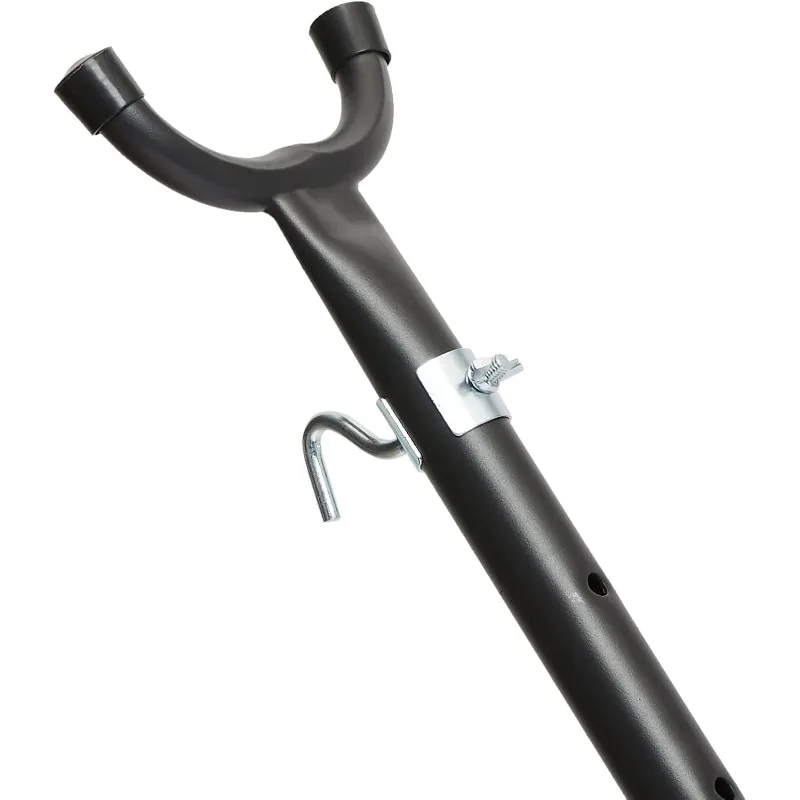
For those considering alternatives to traditional rope designs, quilted fabric hammock sets offer different comfort and durability characteristics worth exploring.
Expert Care Tips for Rope Hammocks
Regardless of which material you choose, proper care significantly extends the life of your hammock:
For Cotton Hammocks:
* Clean with mild soap and cold water, gently scrubbing with a soft brush
* Rinse thoroughly to remove all soap residue
* Allow to dry completely (24+ hours) before storing or using
* Store in a breathable cotton bag, not plastic, when not in use
* Keep indoors during extended rainy periods
* Apply fabric protector designed for outdoor cotton to improve weather resistance
* Inspect regularly for mildew growth, treating immediately if found
For Polyester Hammocks:
* Rinse occasionally with a garden hose to remove surface dirt
* Clean stains with mild soap and water as needed
* Allow to air dry before use (typically 1-2 hours)
* Remove heavy debris (leaves, twigs) that might cause staining
* Check connection points and hardware annually for wear
* Tighten any loose rope sections as needed
For All Rope Hammocks:
* Distribute weight evenly across the center when using
* Avoid sharp objects that might snag or cut ropes
* Follow weight capacity guidelines strictly
* Keep away from fire pits and grills
* Consider fabric hammock options for environments with high exposure to sunscreen or food spills
Sustainability and Environmental Impact
The environmental footprint of your hammock choice deserves consideration:
Cotton is a natural, renewable resource that biodegrades at the end of its life. However, conventional cotton production requires significant water usage and often involves pesticides. Organic cotton hammocks, though harder to find, offer a more environmentally friendly alternative but typically come with higher prices and the same durability limitations.
Polyester is petroleum-based and not biodegradable, potentially lasting hundreds of years in landfills. However, its longer useful lifespan means fewer replacements over time. Some manufacturers now offer recycled polyester hammocks made from post-consumer plastic, reducing virgin petroleum demand.
From a lifetime environmental impact perspective, the calculation is complex: cotton hammocks might require replacement 2-3 times during the lifespan of one polyester hammock, potentially generating more total waste despite being biodegradable.
For environmentally conscious consumers, seeking hammocks from brands that use responsible production methods and exploring our rope hammock sets with recycled or sustainable materials can help reduce environmental impact.
Is a Hybrid Option Right for You?
Some manufacturers offer blended or hybrid hammocks that attempt to combine the best qualities of both materials. These typically feature one of the following approaches:
- Cotton/polyester blended ropes that incorporate both fibers in the same cord
- Different materials for different parts (polyester for structural components, cotton for body-contact areas)
- Special treatments on polyester to mimic cotton’s feel while maintaining durability
Hybrid options aim to deliver a middle ground: better weather resistance than pure cotton but improved comfort compared to standard polyester. While they don’t perfectly match cotton’s softness or polyester’s durability, they offer a compromise that works well for many users.
These blended options typically fall between pure cotton and polyester in price, with lifespans that exceed cotton but may not match high-end polyester. They represent a practical choice for those who can’t decide between the two main options or have mixed priorities.
For those interested in hammock structure beyond materials, our ultimate guide to framed spreader bar hammocks explores how different designs affect comfort and durability.
When to Choose Cotton: The Definitive Answer
Cotton rope hammocks are the definitive choice when:
- Your hammock will hang in a covered porch, gazebo, sunroom, or indoor setting
- Immediate, out-of-the-box comfort is your highest priority
- You appreciate traditional craftsmanship and natural aesthetics
- The hammock will receive light to moderate use
- You’re willing to bring it indoors during inclement weather
- Regular maintenance fits your lifestyle
- You have storage space available for off-season protection
- The direct feel of the hammock against your skin matters significantly
Premium cotton options like hand-woven or organic cotton hammocks offer the pinnacle of traditional comfort, though they require the same care considerations as standard cotton. For complete relaxation systems, explore various hammocks with stands available in cotton.
When to Choose Polyester: The Definitive Answer
Polyester rope hammocks are clearly superior when:
- Your hammock will be placed in an exposed yard, poolside, or beachfront setting
- You want a “set it and forget it” solution with minimal maintenance
- Durability and longevity matter more than initial softness
- The hammock will receive heavy or frequent use
- You prefer to leave your hammock outdoors year-round
- Kids, pets, or frequent guests will use the hammock
- You live in areas with high humidity, frequent rain, or intense sunlight
- You want consistent performance without stretching or adjustment
Modern premium polyester hammocks have largely addressed historical comfort concerns through soft-spun technology and improved weaving techniques. Those seeking versatility should consider portable hammocks with stands in weather-resistant polyester for flexible placement options.
Safety Considerations for Rope Hammocks
Safety should factor into your hammock material decision:
Weight Capacity Integrity:
Polyester typically maintains its rated weight capacity throughout its lifespan, while cotton’s weight-bearing ability may diminish over time. Always respect the manufacturer’s weight limits, which usually range from 275-650 pounds depending on size and construction.
Rope Condition Monitoring:
Regularly inspect ropes for fraying, thinning, or weakness, particularly at stress points where the rope meets hardware or spreader bars. Cotton requires more frequent inspection due to faster deterioration rates.
Child Safety:
The open weave of rope hammocks requires supervision for small children who could potentially get fingers or limbs caught between ropes. Proper indoor and outdoor hammock safety practices are essential, especially when children are present.
Proper Installation:
Both materials require correct installation to prevent accidents. Ensure adequate distance from trees or posts (usually 12-15 feet), proper hanging height (18-24 inches from the ground when weighted), and secure attachment points rated for at least 300 pounds.
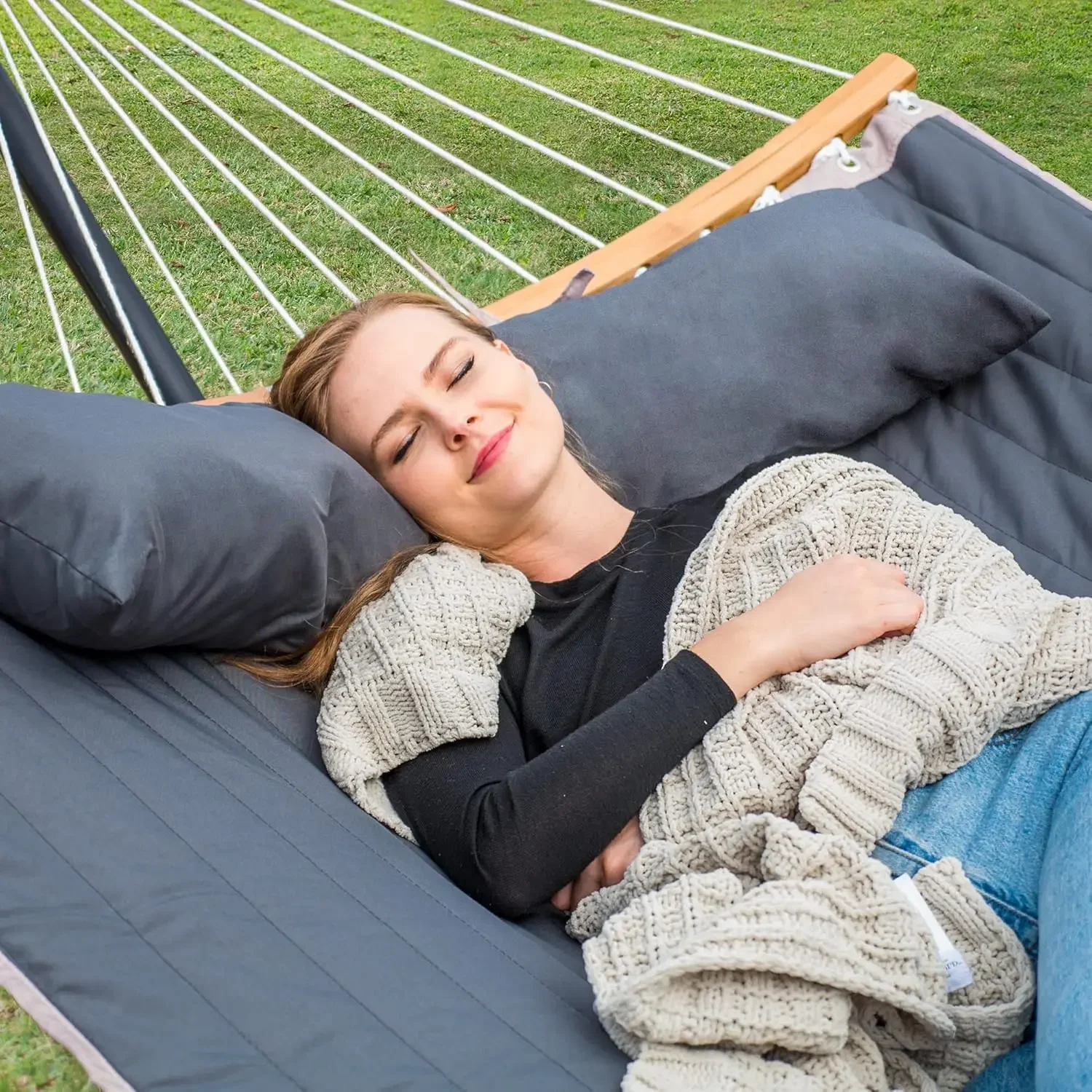
By carefully considering all these factors—comfort, durability, maintenance, environment, and safety—you can select the perfect rope hammock material for your specific needs and enjoy countless hours of relaxation in your outdoor retreat.

